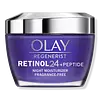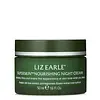What's inside
What's inside
 Key Ingredients
Key Ingredients

 Benefits
Benefits

 Concerns
Concerns

 Ingredients Side-by-side
Ingredients Side-by-side

Water
Skin ConditioningDimethicone
EmollientGlycerin
HumectantTapioca Starch
Dimethicone Crosspolymer
Emulsion StabilisingRetinol
Skin ConditioningRetinyl Propionate
Skin ConditioningNiacinamide
SmoothingPalmitoyl Pentapeptide-4
Skin ConditioningPolyacrylamide
C13-14 Isoparaffin
EmollientDMDM Hydantoin
PreservativePolysorbate 20
EmulsifyingLaureth-4
EmulsifyingAcrylates/C10-30 Alkyl Acrylate Crosspolymer
Emulsion StabilisingLaureth-7
EmulsifyingDimethiconol
EmollientPolymethylsilsesquioxane
Aminomethyl Propanol
BufferingTitanium Dioxide
Cosmetic ColorantDisodium EDTA
Iodopropynyl Butylcarbamate
PreservativeCaprylic/Capric Triglyceride
MaskingAminopeptidase
Skin ConditioningWater, Dimethicone, Glycerin, Tapioca Starch, Dimethicone Crosspolymer, Retinol, Retinyl Propionate, Niacinamide, Palmitoyl Pentapeptide-4, Polyacrylamide, C13-14 Isoparaffin, DMDM Hydantoin, Polysorbate 20, Laureth-4, Acrylates/C10-30 Alkyl Acrylate Crosspolymer, Laureth-7, Dimethiconol, Polymethylsilsesquioxane, Aminomethyl Propanol, Titanium Dioxide, Disodium EDTA, Iodopropynyl Butylcarbamate, Caprylic/Capric Triglyceride, Aminopeptidase
Water
Skin ConditioningGlycerin
HumectantBorago Officinalis Seed Oil
EmollientVaccinium Macrocarpon Seed Oil
Skin ConditioningCaprylic/Capric Triglyceride
MaskingPersea Gratissima Oil
Skin ConditioningSucrose Palmitate
EmollientButyrospermum Parkii Butter
Skin ConditioningRosa Rubiginosa Seed Oil
EmollientMauritia Flexuosa Fruit Oil
Skin ConditioningCetearyl Alcohol
EmollientTocopherol
AntioxidantAlbizia Julibrissin Bark Extract
MaskingGlycine Soja Oil
EmollientCitrus Aurantium Amara Leaf/Twig Oil
MaskingLavandula Hybrida Oil
EmollientAnthemis Nobilis Flower Oil
MaskingPunica Granatum Flower Extract
Skin ConditioningCitrus Aurantium Amara Flower Oil
MaskingMaltodextrin
AbsorbentPhenoxyethanol
PreservativeSodium Polyacrylate
AbsorbentXanthan Gum
EmulsifyingBenzoic Acid
MaskingDehydroacetic Acid
PreservativeLinalool
PerfumingSodium Ascorbyl Phosphate
AntioxidantParfum
MaskingSodium Benzoate
MaskingGeraniol
PerfumingLimonene
PerfumingCitric Acid
BufferingWater, Glycerin, Borago Officinalis Seed Oil, Vaccinium Macrocarpon Seed Oil, Caprylic/Capric Triglyceride, Persea Gratissima Oil, Sucrose Palmitate, Butyrospermum Parkii Butter, Rosa Rubiginosa Seed Oil, Mauritia Flexuosa Fruit Oil, Cetearyl Alcohol, Tocopherol, Albizia Julibrissin Bark Extract, Glycine Soja Oil, Citrus Aurantium Amara Leaf/Twig Oil, Lavandula Hybrida Oil, Anthemis Nobilis Flower Oil, Punica Granatum Flower Extract, Citrus Aurantium Amara Flower Oil, Maltodextrin, Phenoxyethanol, Sodium Polyacrylate, Xanthan Gum, Benzoic Acid, Dehydroacetic Acid, Linalool, Sodium Ascorbyl Phosphate, Parfum, Sodium Benzoate, Geraniol, Limonene, Citric Acid
 Reviews
Reviews

Ingredients Explained
These ingredients are found in both products.
Ingredients higher up in an ingredient list are typically present in a larger amount.
This ingredient is an emollient, solvent, and texture enhancer. It is considered a skin-softener by helping the skin prevent moisture loss.
It helps thicken a product's formula and makes it easier to spread by dissolving clumping compounds.
Caprylic Triglyceride is made by combining glycerin with coconut oil, forming a clear liquid.
While there is an assumption Caprylic Triglyceride can clog pores due to it being derived from coconut oil, there is no research supporting this.
Learn more about Caprylic/Capric TriglycerideGlycerin is already naturally found in your skin. It helps moisturize and protect your skin.
A study from 2016 found glycerin to be more effective as a humectant than AHAs and hyaluronic acid.
As a humectant, it helps the skin stay hydrated by pulling moisture to your skin. The low molecular weight of glycerin allows it to pull moisture into the deeper layers of your skin.
Hydrated skin improves your skin barrier; Your skin barrier helps protect against irritants and bacteria.
Glycerin has also been found to have antimicrobial and antiviral properties. Due to these properties, glycerin is often used in wound and burn treatments.
In cosmetics, glycerin is usually derived from plants such as soybean or palm. However, it can also be sourced from animals, such as tallow or animal fat.
This ingredient is organic, colorless, odorless, and non-toxic.
Glycerin is the name for this ingredient in American English. British English uses Glycerol/Glycerine.
Learn more about GlycerinWater. It's the most common cosmetic ingredient of all. You'll usually see it at the top of ingredient lists, meaning that it makes up the largest part of the product.
So why is it so popular? Water most often acts as a solvent - this means that it helps dissolve other ingredients into the formulation.
You'll also recognize water as that liquid we all need to stay alive. If you see this, drink a glass of water. Stay hydrated!
Learn more about Water